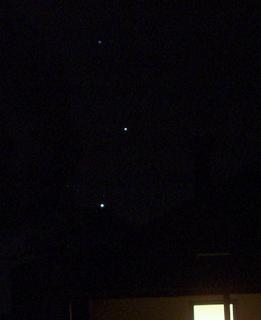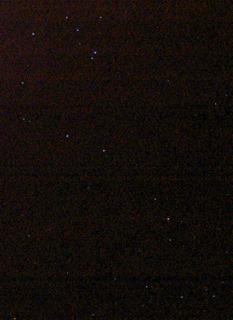Sunday, August 28, 2005
Stargazing at Sandy Creek

Image: Venus, Jupiter and Spica float over the roof of the Sandy Creek Youth Hostel (click image to enlarge for better viewing)
Chez Reynella loves camping. Getting to the campsite, now that can be a very different issue. This time, everything went relatively smoothly, with the exception that the stop at the major Fast Food restaurant, the bribe for good offspring behavior, didn't materialize for some time so there was much mutiny in the ranks (and when we stopped, there were massive delays being served, so much for Fast Food).
We finally made it to the Sandy Creek Youth Hostel, one of the YHA Bush hostels you can book as a group. Chez Reynella was one of three families sharing a weekend bush adventure. A velvet sky stretched overhead, dazzling with stars. Inside, we had a massive communal cookup, played board games with the kids, and went spotlighting for wildlife (two kangaroos and a possum were seen in the immediate vicinity of the house).
After all this excitement, I unpacked my cameras and portable refractor for some serious astronomy.

This is Scorpio, taken with my Olympus [mju:]300 digital (click image to enlarge for better viewing). The camera was tripod mounted, in nightshot mode and triggered remotely. The exposure was roughly 6 seconds long. Click to enlarge. The colours of the stars are rather vivid in this image, I suspect this has more to do with the camera sensitivity than the actual colours of the stars. The star clouds of Scorpio and Sagittarius were clearly visible in the sky, but don't turn up on this image. Well, given it was only a 6 second image, it's not surprising. I'm a bit envious of other digital camera owners who can specify the length of their exposures, although without a clock drive, anything over 10 seconds shows perceptible star trailing, so it's not too much of a gain.

This is a more detailed look at the tail of the Scorpion, take in SuperHigh Quality mode (click image to enlarge for better viewing). The False Comet (or Table of Scorpius) is just visible, and if you have a lively imagination you can just see Ptolomey's cluster just off the tail. I then unpacked the trusty SLR, and set up some 10-15 second shots. It will be a while before I can get these processed, as there is only one camera shop in Adelaide that I know of that still does manual printing of film. The automated machines can't detect the edges of exposures taken at dark sky sites, so they can't develop them.
I then set up a several hour star trail exposure. Unfortunately, the clouds moved in after half an hour and I had to shut down.

We've been to Sandy Creek before. A whole group of us went up to watch the 2003 opposition of Mars on almost the same weekend two years ago. No sooner had the scope been set up, then the clouds came over. The sky cleared at 4.00 am, and I got some of the enthusiasts up, and we had about a minutes view before the clouds came over AGAIN! I didn't get to do anymore astronomy this weekend either. The clouds hung round. That didn't stop us from having massive pancake breakfasts, trekking into the bush, finding amazing ground orchids and list of carnivorous plants, being astounded by birds, encountering lots of wildlife, carting home kangaroo skeletons and exploring old cars. In short, a wonderful time was had by all (and far too much food was eaten)
Comments:
<< Home
Some nice pictures, it's impressive how much detail digital cameras can pick up in short exposures. I still use my trusty old SLR for most astronomical imaging and have also had problems getting the results developed. What I do now is take slides and get them developed uncut, that way you don't run the risk of the machines chopping them in the wrong place and you can cut and mount the best ones yourself. I guess when film becomes difficult to get hold of then I might give in and get a digital SLR, but I hope that doesn't happen for a while yet.
Post a Comment
<< Home




 Click to read about or order
Click to read about or order Click to read about or order
Click to read about or order Click to read about or order
Click to read about or order Click to read about or order
Click to read about or order




